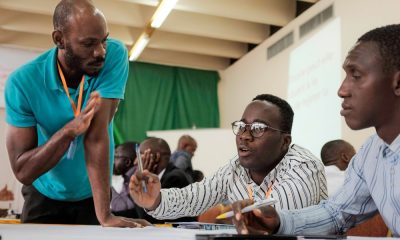Tech
Better democracy through technology
Published
2 years agoon
By
Terry Power
When Mike Koval, the police chief of Madison, Wisconsin, abruptly resigned on a Sunday in September 2019, the community’s relationship with its men and women in blue was already strained. Use-of-force issues hung over the department after the killing of a Black teenager in 2015. Then, months before Koval left, another Black teenager, in the middle of a mental health crisis, was beaten on the head by an officer while being restrained by three others.
The process of selecting a new police chief followed a standard formula. A five-person team of mayor-appointed, city-council-approved commissioners would make the ultimate decision, allowing for public comment beforehand. But this time, the commissioners wanted that public input to involve more of the local community than just the folks who regularly appeared at town-hall-style meetings.
To gather more meaningful community feedback based on “lived experiences,” the commission took a new approach in which small groups of citizens—many from Madison’s most underheard neighborhoods—were brought together in a nonthreatening environment. Facilitators guided people who differed in age, ethnicity, gender, and socioeconomic status through intimate discussions on topics including what their own relationships with the police were like; whether they trusted or feared them; how they’d seen officers interact with kids and adults; and what type of training they thought police should receive to deal with stressful situations.
“The way we’re speaking with others is fundamentally broken. In every measurable way, things are getting more fractured and polarized.”
These conversations were recorded as part of an initiative called the Local Voices Network (LVN), which worked closely with the nonprofit Cortico and MIT’s Laboratory for Social Machines (LSM), headed by Professor Deb Roy. What made the process unique—and a potential model for other municipalities—was what happened next.
With help from machine-learning technology that Roy and an interdisciplinary team had developed over the past five years, MIT researchers sifted through hundreds of hours of audio to define topics and summarize larger conversations into snippets of text. By using this technology to augment human listening, the researchers were able to highlight parts of the conversations and identify the themes of greatest concern. The insights of 48 people in 31 different conversations were highlighted. The topics that emerged as common concerns became the basis for interview questions asked of the candidates to succeed Koval. Of the six final questions put before the four finalists, three came directly from the community conversations.
The facilitated work in Madison was a natural extension of Roy’s research in social media analytics. The scope of this work was further advanced when, in January 2021, MIT announced that the Laboratory for Social Machines would be expanded into an Institute-wide Center for Constructive Communication (CCC) based within the MIT Media Lab. The center will continue to work closely with Cortico, which Roy currently chairs. The two entities are now working hand in hand on building, as Roy says, “power tools” for democracy.
In Madison, thanks to tools like those, “we were able to actually uplift the specific concerns of a variety of members of the community,” says Colleen Butler, former director of capacity building at Cortico.
According to Roy, that’s how civic dialogue is supposed to work: various voices learning from each other to bridge divides and inform public policymaking. Instead, what he currently sees is a fragmented, reactive, angry world where vitriol and provocation score more points than conversation and understanding.
“The way we’re speaking with others is fundamentally broken,” he says. “In every measurable way, things are getting more fractured and polarized.”
For more than two decades, Roy has been deeply immersed in studying the complexity of human communication. Today, by combining that study with work on social-impact technology, he hopes to foster more constructive personal connections and enhance civic discourse. His aim is to find much-needed civility and common ground both in person and in social networks.
Reframing conversation
Most parents-to-be obsess over necessities like the crib, the bottles, and the pacifiers. Deb Roy had another item on his list: audio equipment.
In 2005, just before his son was born, Roy outfitted his home with 11 video cameras and 14 microphones. Over three years, he collected data—90,000 hours of video, 140,000 hours of audio—on how familial interactions affected his son’s speech development. Dubbed the Human Speechome Project, it built on Roy’s PhD dissertation, which focused on developing machine-learning models of human language. (He gave a TED talk about the experience in 2011.)
Roy’s key insight from the project was the notion of recurrent shared contexts. Parents don’t generally talk to their infants about objects or people not in the room. To foster language learning, it’s more helpful to use words in reference to something the infants and caregivers can perceive or participate in together. Roy wondered where else that sort of phenomenon might be found. Michael Fleischman, a PhD student in his research group, had an idea: the way people talk about TV. It was only a couple years after Twitter was founded, in 2006, that Roy and Fleischman discovered there were social media users who talk about television shows and commercials airing in real time, without even knowing each other.
TED CONFERENCE
“That’s how we ended up looking at tweets and other social media that were about what was on television,” says Roy. “You have this shared context. People tuned in to a live broadcast, and then talked to one another or just broadcasted, into the ether, reactions.”
He and Fleischman thought this was the basis for a good business idea. Advertisers have large research budgets for the purpose of figuring out how to help them connect with would-be consumers. In 2008, Roy took an extended leave from MIT, and the pair founded Bluefin Labs, a social analytics startup, to help companies analyze what everyday people were saying about television programs and advertising. Using algorithms, the startup could pick out millions of online comments made about a show or commercial in the hours immediately after it aired. Seeing that sort of information could then help networks and companies understand what was resonating with audiences, especially in the ever-growing online sphere.
“Companies that figure this out will thrive in the next 10 to 15 years. Companies that don’t will fail,” said a Nielsen executive quoted in a profile of the company published in MIT Technology Review in 2011.
Bluefin Labs was acquired by Twitter in 2013 for $100 million. For Roy, it served as a jumping-off point to his current work. He took a four-year role as Twitter’s chief media scientist, but he also went back to MIT.
“I knew that my long-term goal was to return to research,” he says. “My interest was to create a new kind of lab which could straddle the incredibly rich environment of doing explanatory and fundamental research with the skill set and all the things we did at Bluefin and Twitter.”
Forget analyzing the semantic patterns of the online world to figure out whether people liked a product being hawked during a commercial break: Roy wanted to take what he had learned at Bluefin, where he’d translated research into practical products and services, and apply those findings for noncommercial societal benefit. That’s when, in 2014, he set up the LSM at the Media Lab, with Twitter as a founding partner and main funder. He tapped Russell Stevens, a friend and previous advisor at Bluefin with a background in media and marketing, to help establish the lab.
What the researchers discovered this time when they examined tweets and other social media posts was something wholly different from what they’d seen in the world of entertainment TV: a crumbling social context instead of a cohesive one. After the Boston Marathon bombing, rumors spread like wildfire. During the 2016 presidential election, unverified reports were shared widely. Big news events came and went, playing out for all to see, but people reacted differently depending on what they heard and what they believed.
Through research at the lab, Roy, Stevens, and the LSM team tried to make sense of it—even going so far as to analyze millions of tweets to discern how false news spread through Twitter. (The resulting paper, which Roy coauthored, appeared on the cover of Sciencein 2018.) But to actually bridge those social divides, collaborators at the lab realized, they had to marry real-life conversations with the computational social science started at Bluefin and further developed at the LSM.
“If we really wanted to understand why we may be fragmenting into isolated tribes, we actually had to go talk to people,” Stevens says. “That’s the only solution.”
Finding common ground
Bringing conversations in the online world back to earth, so to speak, was Roy’s purpose in creating the Center for Constructive Communication. The announcement that introduced the new center characterized it as an “evolution” of the LSM. Unlike the LSM, though, it has a mandate to reach beyond academia—to bring the tools of data-driven analytics to bear on conversations about society, culture, and politics, and then to see where connections between people can be made.
“A democracy can’t function if the public is so divided and unable to listen to each other,” says Ceasar McDowell, the center’s associate director. “What we find out is that people aren’t as far apart as you think, but they don’t have the space where they feel that they will be heard and listened to in order to find that connection.”
That’s where Cortico comes in. Founded in 2016, with Roy and Stevens as two of the three cofounders, the nonprofit aimed primarily to facilitate on-the-ground conversations—first with the social tools that the LSM was developing, and now with interpersonal technologies being created by CCC and Cortico. CCC, which leads research in analytics and design research, partners with Cortico to develop prototype translations of research that can be tested with field partners—often local, grassroots organizations. Cortico then integrates findings from successful pilot programs into the LVN platform, which it independently develops and operates.
Can the marriage of real-life conversations with advanced digital technology put us on the road to becoming better citizens? Professor Deb Roy thinks so.
That platform, Cortico’s core initiative, is where the audio from these types of community conversations gets stored. Analytics tools—similar to what Bluefin Labs pioneered a decade ago—sift through the talk to find the common ground, and then to amplify those representative perspectives. Audio transcripts are made, and as the computer goes through the text, it picks out key points from conversations. Afterward, anyone can go back and listen to a particular segment to get the full context. CCC calls it “sense-making.”
To Jacquelyn Boggess, one of the commissioners involved in picking Madison’s police chief, the insights gained this way proved invaluable. Typically, the people who show up at town halls are telling commissioners which person to pick. The conversations with Madison’s citizens, she says, instead gave her a chance to hear how her decision might affect them.
“They’re not telling me who to choose. They’re telling me who they are and what they need,” Boggess says. “People told me stories of their lives and what goes on in their lives, as opposed to telling me who they think I should choose for police chief, and that was much more helpful.”
In late 2020, the LSM and Cortico used the LVN process to connect with citizens in Atlanta during the covid pandemic. As part of a collaboration with the Atlanta-based Task Force for Global Health, Cortico set up virtual group conversations of about six to eight people. They spoke about their fears of the new disease, the questions they had about staying safe, and their concerns about how covid testing was conducted. Cortico and LSM researchers (CCC was still a few weeks away from being announced) shared insights from those conversations with Black ministers, who they hoped could answer those questions for their congregations. In early 2021, LVN came in handy again as vaccines were being rolled out. “As the vaccine gained steam, we were able to tap into what folks were saying on the ground,” says Stevens. The platform gave residents a chance to express any concerns they had about receiving a vaccination; again, the team then spun up the results into messaging that could be distributed by trusted voices in various city neighborhoods.
Kick-starting a revolution
In the future, Roy hopes to expand the capabilities of CCC, Cortico, and LVN. Some of that will be accomplished through hardware designed to use during these group conversations: a portable recording device called a “digital hearth,” which is supposed to be a little more inviting than just a smartphone or microphone sitting in the center of a table. At the same time, Cortico is designing programs to train community organizers and volunteers on how to organize and facilitate local conversations.
“In general, online spaces, in order to meet certain design objectives and commercial objectives, tend to be disconnected from the in-person world,” Roy says. “We’re interested in weaving these back together.”
If a series of personal conversations could help Madison residents grapple with an issue as contentious as policing, and establish enough common ground to inform the questions asked in the official interviews, it seems to indicate that the process could work.
“I think it allows for greater transparency and community involvement—and, frankly, a more thoughtful process—than the more typical town hall type of meetings can offer,” says Butler.
Kick-starting a revolution in civic discourse is currently at the forefront of Roy’s mind. Right now, CCC is working on a new dashboard feature that would connect to information collected and organized in the LVN platform. A journalist set to moderate a public debate, for example, would be able to craft questions that address what’s on the minds of city residents as opposed to just picking a tweet or online comment at random. In fact, that’s exactly what is starting to happen with a new initiative in Boston.
Roy is careful to hedge his bets on how successful these new approaches can be. “The spaces for what we would call constructive conversation and constructive dialogue are shrinking,” he says. “I guess I know enough to realize it’d be naïve to think we’re going to fix that.”
Still, the tools he’s creating are unquestionably a start.
You may like
-


How a half-trillion dollars is transforming climate technology
-


Introducing MIT Technology Review Roundtables, real-time conversations about what’s next in tech
-


‘Gene Silencing’ Technology Offers Fresh Hope For Alzheimer’s Patients
-


This technology could alter the entire planet. These groups want every nation to have a say.
-


The hottest new climate technology is bricks
-


Technology and industry convergence: A historic opportunity

My senior spring in high school, I decided to defer my MIT enrollment by a year. I had always planned to take a gap year, but after receiving the silver tube in the mail and seeing all my college-bound friends plan out their classes and dorm decor, I got cold feet. Every time I mentioned my plans, I was met with questions like “But what about school?” and “MIT is cool with this?”
Yeah. MIT totally is. Postponing your MIT start date is as simple as clicking a checkbox.
COURTESY PHOTO
Now, having finished my first year of classes, I’m really grateful that I stuck with my decision to delay MIT, as I realized that having a full year of unstructured time is a gift. I could let my creative juices run. Pick up hobbies for fun. Do cool things like work at an AI startup and teach myself how to create latte art. My favorite part of the year, however, was backpacking across Europe. I traveled through Austria, Slovakia, Russia, Spain, France, the UK, Greece, Italy, Germany, Poland, Romania, and Hungary.
Moreover, despite my fear that I’d be losing a valuable year, traveling turned out to be the most productive thing I could have done with my time. I got to explore different cultures, meet new people from all over the world, and gain unique perspectives that I couldn’t have gotten otherwise. My travels throughout Europe allowed me to leave my comfort zone and expand my understanding of the greater human experience.
“In Iceland there’s less focus on hustle culture, and this relaxed approach to work-life balance ends up fostering creativity. This was a wild revelation to a bunch of MIT students.”
When I became a full-time student last fall, I realized that StartLabs, the premier undergraduate entrepreneurship club on campus, gives MIT undergrads a similar opportunity to expand their horizons and experience new things. I immediately signed up. At StartLabs, we host fireside chats and ideathons throughout the year. But our flagship event is our annual TechTrek over spring break. In previous years, StartLabs has gone on TechTrek trips to Germany, Switzerland, and Israel. On these fully funded trips, StartLabs members have visited and collaborated with industry leaders, incubators, startups, and academic institutions. They take these treks both to connect with the global startup sphere and to build closer relationships within the club itself.
Most important, however, the process of organizing the TechTrek is itself an expedited introduction to entrepreneurship. The trip is entirely planned by StartLabs members; we figure out travel logistics, find sponsors, and then discover ways to optimize our funding.

COURTESY PHOTO
In organizing this year’s trip to Iceland, we had to learn how to delegate roles to all the planners and how to maintain morale when making this trip a reality seemed to be an impossible task. We woke up extra early to take 6 a.m. calls with Icelandic founders and sponsors. We came up with options for different levels of sponsorship, used pattern recognition to deduce the email addresses of hundreds of potential contacts at organizations we wanted to visit, and all got scrappy with utilizing our LinkedIn connections.
And as any good entrepreneur must, we had to learn how to be lean and maximize our resources. To stretch our food budget, we planned all our incubator and company visits around lunchtime in hopes of getting fed, played human Tetris as we fit 16 people into a six-person Airbnb, and emailed grocery stores to get their nearly expired foods for a discount. We even made a deal with the local bus company to give us free tickets in exchange for a story post on our Instagram account.
Tech
The Download: spying keyboard software, and why boring AI is best
Published
9 months agoon
22 August 2023By
Terry Power
This is today’s edition of The Download, our weekday newsletter that provides a daily dose of what’s going on in the world of technology.
How ubiquitous keyboard software puts hundreds of millions of Chinese users at risk
For millions of Chinese people, the first software they download onto devices is always the same: a keyboard app. Yet few of them are aware that it may make everything they type vulnerable to spying eyes.
QWERTY keyboards are inefficient as many Chinese characters share the same latinized spelling. As a result, many switch to smart, localized keyboard apps to save time and frustration. Today, over 800 million Chinese people use third-party keyboard apps on their PCs, laptops, and mobile phones.
But a recent report by the Citizen Lab, a University of Toronto–affiliated research group, revealed that Sogou, one of the most popular Chinese keyboard apps, had a massive security loophole. Read the full story.
—Zeyi Yang
Why we should all be rooting for boring AI
Earlier this month, the US Department of Defense announced it is setting up a Generative AI Task Force, aimed at “analyzing and integrating” AI tools such as large language models across the department. It hopes they could improve intelligence and operational planning.
But those might not be the right use cases, writes our senior AI reporter Melissa Heikkila. Generative AI tools, such as language models, are glitchy and unpredictable, and they make things up. They also have massive security vulnerabilities, privacy problems, and deeply ingrained biases.
Applying these technologies in high-stakes settings could lead to deadly accidents where it’s unclear who or what should be held responsible, or even why the problem occurred. The DoD’s best bet is to apply generative AI to more mundane things like Excel, email, or word processing. Read the full story.
This story is from The Algorithm, Melissa’s weekly newsletter giving you the inside track on all things AI. Sign up to receive it in your inbox every Monday.
The ice cores that will let us look 1.5 million years into the past
To better understand the role atmospheric carbon dioxide plays in Earth’s climate cycles, scientists have long turned to ice cores drilled in Antarctica, where snow layers accumulate and compact over hundreds of thousands of years, trapping samples of ancient air in a lattice of bubbles that serve as tiny time capsules.
By analyzing those cores, scientists can connect greenhouse-gas concentrations with temperatures going back 800,000 years. Now, a new European-led initiative hopes to eventually retrieve the oldest core yet, dating back 1.5 million years. But that impressive feat is still only the first step. Once they’ve done that, they’ll have to figure out how they’re going to extract the air from the ice. Read the full story.
—Christian Elliott
This story is from the latest edition of our print magazine, set to go live tomorrow. Subscribe today for as low as $8/month to ensure you receive full access to the new Ethics issue and in-depth stories on experimental drugs, AI assisted warfare, microfinance, and more.
The must-reads
I’ve combed the internet to find you today’s most fun/important/scary/fascinating stories about technology.
1 How AI got dragged into the culture wars
Fears about ‘woke’ AI fundamentally misunderstand how it works. Yet they’re gaining traction. (The Guardian)
+ Why it’s impossible to build an unbiased AI language model. (MIT Technology Review)
2 Researchers are racing to understand a new coronavirus variant
It’s unlikely to be cause for concern, but it shows this virus still has plenty of tricks up its sleeve. (Nature)
+ Covid hasn’t entirely gone away—here’s where we stand. (MIT Technology Review)
+ Why we can’t afford to stop monitoring it. (Ars Technica)
3 How Hilary became such a monster storm
Much of it is down to unusually hot sea surface temperatures. (Wired $)
+ The era of simultaneous climate disasters is here to stay. (Axios)
+ People are donning cooling vests so they can work through the heat. (Wired $)
4 Brain privacy is set to become important
Scientists are getting better at decoding our brain data. It’s surely only a matter of time before others want a peek. (The Atlantic $)
+ How your brain data could be used against you. (MIT Technology Review)
5 How Nvidia built such a big competitive advantage in AI chips
Today it accounts for 70% of all AI chip sales—and an even greater share for training generative models. (NYT $)
+ The chips it’s selling to China are less effective due to US export controls. (Ars Technica)
+ These simple design rules could turn the chip industry on its head. (MIT Technology Review)
6 Inside the complex world of dissociative identity disorder on TikTok
Reducing stigma is great, but doctors fear people are self-diagnosing or even imitating the disorder. (The Verge)
7 What TikTok might have to give up to keep operating in the US
This shows just how hollow the authorities’ purported data-collection concerns really are. (Forbes)
8 Soldiers in Ukraine are playing World of Tanks on their phones
It’s eerily similar to the war they are themselves fighting, but they say it helps them to dissociate from the horror. (NYT $)
9 Conspiracy theorists are sharing mad ideas on what causes wildfires
But it’s all just a convoluted way to try to avoid having to tackle climate change. (Slate $)
10 Christie’s accidentally leaked the location of tons of valuable art 

Seemingly thanks to the metadata that often automatically attaches to smartphone photos. (WP $)
Quote of the day
“Is it going to take people dying for something to move forward?”
—An anonymous air traffic controller warns that staffing shortages in their industry, plus other factors, are starting to threaten passenger safety, the New York Times reports.
The big story
Inside effective altruism, where the far future counts a lot more than the present

October 2022
Since its birth in the late 2000s, effective altruism has aimed to answer the question “How can those with means have the most impact on the world in a quantifiable way?”—and supplied methods for calculating the answer.
It’s no surprise that effective altruisms’ ideas have long faced criticism for reflecting white Western saviorism, alongside an avoidance of structural problems in favor of abstract math. And as believers pour even greater amounts of money into the movement’s increasingly sci-fi ideals, such charges are only intensifying. Read the full story.
—Rebecca Ackermann
We can still have nice things
A place for comfort, fun and distraction in these weird times. (Got any ideas? Drop me a line or tweet ’em at me.)
+ Watch Andrew Scott’s electrifying reading of the 1965 commencement address ‘Choose One of Five’ by Edith Sampson.
+ Here’s how Metallica makes sure its live performances ROCK. ($)
+ Cannot deal with this utterly ludicrous wooden vehicle.
+ Learn about a weird and wonderful new instrument called a harpejji.
Tech
Why we should all be rooting for boring AI
Published
9 months agoon
22 August 2023By
Terry Power
This story originally appeared in The Algorithm, our weekly newsletter on AI. To get stories like this in your inbox first, sign up here.
I’m back from a wholesome week off picking blueberries in a forest. So this story we published last week about the messy ethics of AI in warfare is just the antidote, bringing my blood pressure right back up again.
Arthur Holland Michel does a great job looking at the complicated and nuanced ethical questions around warfare and the military’s increasing use of artificial-intelligence tools. There are myriad ways AI could fail catastrophically or be abused in conflict situations, and there don’t seem to be any real rules constraining it yet. Holland Michel’s story illustrates how little there is to hold people accountable when things go wrong.
Last year I wrote about how the war in Ukraine kick-started a new boom in business for defense AI startups. The latest hype cycle has only added to that, as companies—and now the military too—race to embed generative AI in products and services.
Earlier this month, the US Department of Defense announced it is setting up a Generative AI Task Force, aimed at “analyzing and integrating” AI tools such as large language models across the department.
The department sees tons of potential to “improve intelligence, operational planning, and administrative and business processes.”
But Holland Michel’s story highlights why the first two use cases might be a bad idea. Generative AI tools, such as language models, are glitchy and unpredictable, and they make things up. They also have massive security vulnerabilities, privacy problems, and deeply ingrained biases.
Applying these technologies in high-stakes settings could lead to deadly accidents where it’s unclear who or what should be held responsible, or even why the problem occurred. Everyone agrees that humans should make the final call, but that is made harder by technology that acts unpredictably, especially in fast-moving conflict situations.
Some worry that the people lowest on the hierarchy will pay the highest price when things go wrong: “In the event of an accident—regardless of whether the human was wrong, the computer was wrong, or they were wrong together—the person who made the ‘decision’ will absorb the blame and protect everyone else along the chain of command from the full impact of accountability,” Holland Michel writes.
The only ones who seem likely to face no consequences when AI fails in war are the companies supplying the technology.
It helps companies when the rules the US has set to govern AI in warfare are mere recommendations, not laws. That makes it really hard to hold anyone accountable. Even the AI Act, the EU’s sweeping upcoming regulation for high-risk AI systems, exempts military uses, which arguably are the highest-risk applications of them all.
While everyone is looking for exciting new uses for generative AI, I personally can’t wait for it to become boring.
Amid early signs that people are starting to lose interest in the technology, companies might find that these sorts of tools are better suited for mundane, low-risk applications than solving humanity’s biggest problems.
Applying AI in, for example, productivity software such as Excel, email, or word processing might not be the sexiest idea, but compared to warfare it’s a relatively low-stakes application, and simple enough to have the potential to actually work as advertised. It could help us do the tedious bits of our jobs faster and better.
Boring AI is unlikely to break as easily and, most important, won’t kill anyone. Hopefully, soon we’ll forget we’re interacting with AI at all. (It wasn’t that long ago when machine translation was an exciting new thing in AI. Now most people don’t even think about its role in powering Google Translate.)
That’s why I’m more confident that organizations like the DoD will find success applying generative AI in administrative and business processes.
Boring AI is not morally complex. It’s not magic. But it works.
Deeper Learning
AI isn’t great at decoding human emotions. So why are regulators targeting the tech?
Amid all the chatter about ChatGPT, artificial general intelligence, and the prospect of robots taking people’s jobs, regulators in the EU and the US have been ramping up warnings against AI and emotion recognition. Emotion recognition is the attempt to identify a person’s feelings or state of mind using AI analysis of video, facial images, or audio recordings.
But why is this a top concern? Western regulators are particularly concerned about China’s use of the technology, and its potential to enable social control. And there’s also evidence that it simply does not work properly. Tate Ryan-Mosley dissected the thorny questions around the technology in last week’s edition of The Technocrat, our weekly newsletter on tech policy.
Bits and Bytes
Meta is preparing to launch free code-generating software
A version of its new LLaMA 2 language model that is able to generate programming code will pose a stiff challenge to similar proprietary code-generating programs from rivals such as OpenAI, Microsoft, and Google. The open-source program is called Code Llama, and its launch is imminent, according to The Information. (The Information)
OpenAI is testing GPT-4 for content moderation
Using the language model to moderate online content could really help alleviate the mental toll content moderation takes on humans. OpenAI says it’s seen some promising first results, although the tech does not outperform highly trained humans. A lot of big, open questions remain, such as whether the tool can be attuned to different cultures and pick up context and nuance. (OpenAI)
Google is working on an AI assistant that offers life advice
The generative AI tools could function as a life coach, offering up ideas, planning instructions, and tutoring tips. (The New York Times)
Two tech luminaries have quit their jobs to build AI systems inspired by bees
Sakana, a new AI research lab, draws inspiration from the animal kingdom. Founded by two prominent industry researchers and former Googlers, the company plans to make multiple smaller AI models that work together, the idea being that a “swarm” of programs could be as powerful as a single large AI model. (Bloomberg)
